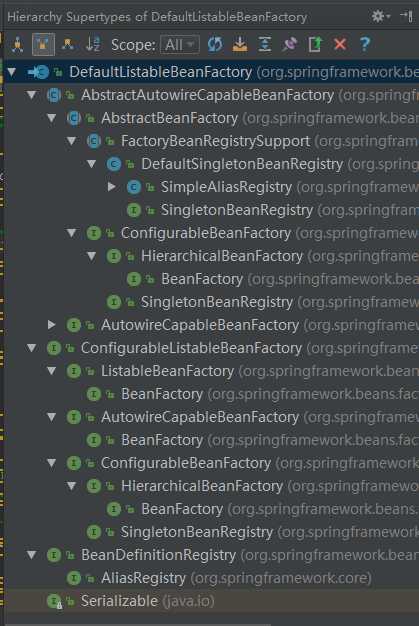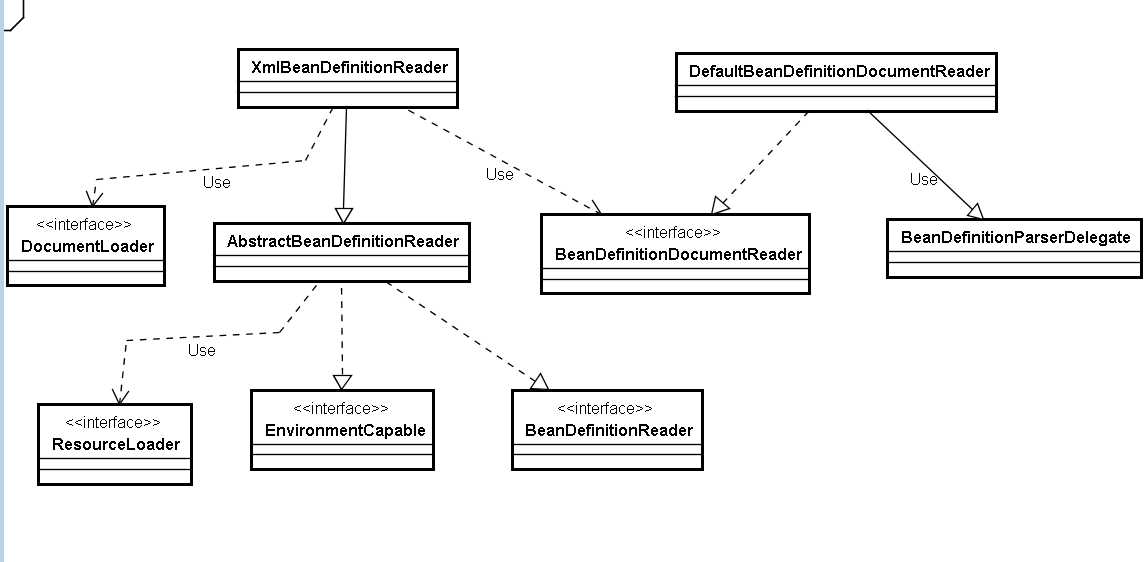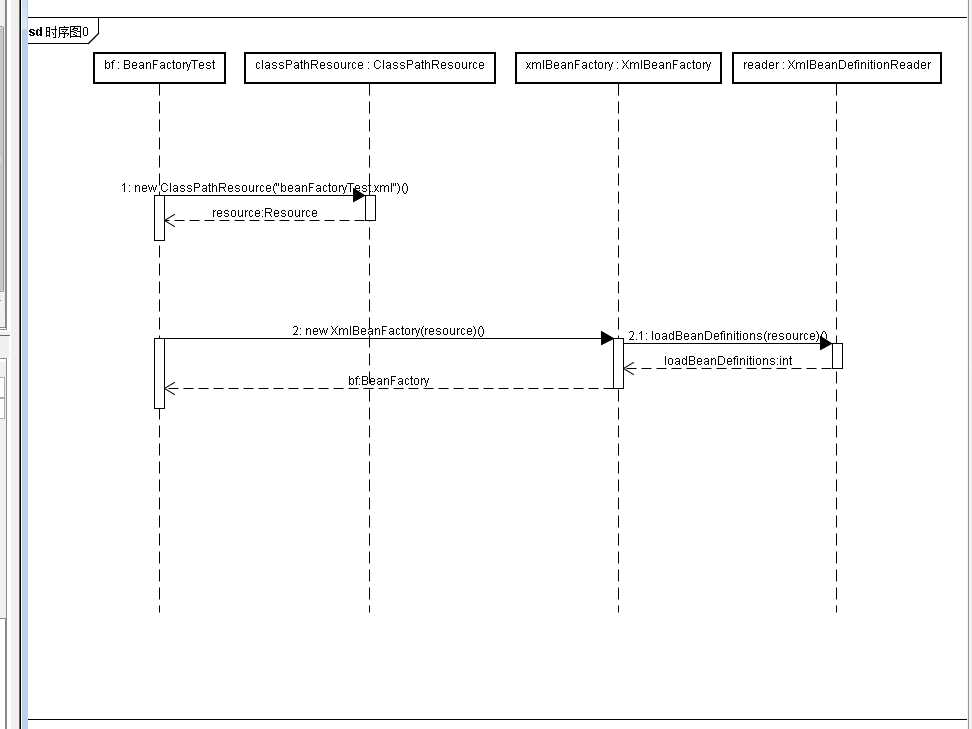容器最基本的实现是beanFactory,但是大部分企业引用都是使用ApplicationContext,这里介绍基础的BeanFactory是为了更好的理解sping内部原理。
(一)基本用法
(1)bean的声明
package com.ws.learn.entity; public class Person { private String name; private Integer age; public String getName() { return name; } public void setName(String name) { this.name = name; } public Integer getAge() { return age; } public void setAge(Integer age) { this.age = age; } public void info(){ System.out.println("name:"+getName()+" age:"+getAge()); } }
(2)配置文件beanFactoryTest.xml
<?xml version="1.0" encoding="UTF-8"?> <beans xmlns:xsi="http://www.w3.org/2001/XMLSchema-instance" xmlns="http://www.springframework.org/schema/beans" xmlns:aop="http://www.springframework.org/schema/aop" xsi:schemaLocation="http://www.springframework.org/schema/beans http://www.springframework.org/schema/beans/spring-beans-3.0.xsd http://www.springframework.org/schema/aop http://www.springframework.org/schema/aop/spring-aop.xsd"> <bean id="person" class="com.ws.learn.entity.Person"> <property name="name" value="test"/> <property name="age" value="18"/> </bean> </beans>
(3)测试
public class MyTest { public static void main(String[] args){ BeanFactory bf = new XmlBeanFactory(new ClassPathResource("beanFactoryTest.xml"));//读取beanFactoryTest.xml中的内容 Person p = bf.getBean("person",Person.class); p.info(); } }
(二)核心类介绍
(1)DefaultListableBeanFactory
XmlBeanFactory继承自DefaultListableBeanFactory,而DefaultListableBeanFactory是整个bean加载的核心部分,是Spring注册及加载bean的默认实现,而对于XmlBeanFactory与DefaultListableBeanFactory不同的地方其实是在XmlBeanFactory中使用了自定义的XML读取器XmlBeanDefinitionReader,实现了个性化的BeanDefinitionReader读取,DefaultListableBeanFactory继承了AbstractAutowireCapableBeanFactory并实现了ConfigURableListableBeanFactory以及BeanDefinitionRegistry接口。以下是ConfigURationListableBeanFactory的层次结构图以下相关类图

容器加载相关类图:

类图中各个类的作用:
- AliasRegistry:定义对alias的简单增删改等操作
- SimpleAliasRegistry:主要使用map作为alias的缓存,并对接口AliasRegistry进行实现
- SingletonBeanRegistry:定义对单例的注册及获取
- BeanFactory:定义获取bean及bean的各种属性
- DefaultSingletonBeanRegistry:对接口SingletonBeanRegistry各函数的实现
- HierarchicalBeanFactory:继承BeanFactory,也就是在BeanFactory定义的功能的基础上增加了对parentFactory的支持
- BeanDefinitionRegistry:定义对BeanDefinition的各种增删改操作
- FactoryBeanRegistrySupport:在DefaultSingletonBeanRegistry基础上增加了对FactoryBean的特殊处理功能
- ConfigurableBeanFactory:提供配置Factory的各种方法
- ListableBeanFactory:根据各种条件获取bean的配置清单
- AbstractBeanFactory:综合FactoryBeanRegistrySupport和ConfigurationBeanFactory的功能
- AutowireCapableBeanFactory:提供创建bean、自动注入、初始化以及应用bean的后处理器
- AbstractAutowireCapableBeanFactory:综合AbstractBeanFactory并对接口AutowireCapableBeanFactory进行实现
- ConfigurableListableBeanFactory:BeanFactory配置清单,指定忽略类型及接口等
- DefaultListableBeanFactory:综合上面所有功能,主要是对Bean注册后的处理
(2)XmlBeanDefinitionReader
XML配置文件的读取是Spring中重要的功能,因为Spring的大部分功能都是以配置作为切入点的,可以从XmlBeanDefinitionReader中梳理一下资源文件读取、解析及注册的大致脉络,首先看看各个类的功能
- ResourceLoader:定义资源加载器,主要应用于根据给定的资源文件地址返回对应的Resource
- BeanDefinitionReader:主要定义资源文件读取并转换为BeanDefinition的各个功能
- EnvironmentCapable:定义获取Environment方法
- DocumentLoader:定义从资源文件加载到转换为Document的功能
- AbstractBeanDefinitionReader:对EnvironmentCapable、BeanDefinitionReader类定义的功能进行实现
- BeanDefinitionDocumentReader:定义读取Document并注册BeanDefinition功能
- BeanDefinitionParserDelegate:定义解析Element的各种方法
整个XML配置文件读取的大致流程,在XmlBeanDefinitionReader中主要包含以下几步处理:

(1)通过继承自AbstractBeanDefinitionReader中的方法,来使用ResourceLoader将资源文件路径转换为对应的Resource文件
(2)通过DocumentLoader对Resource文件进行转换,将Resource文件转换为Document文件
(3)通过实现接口BeanDefinitionDocumentReader的DefaultBeanDefinitionDocumentReader类对Document进行解析,并使用BeanDefinitionParserDelegate对Element进行解析
(三)容器的基础XmlBeanFactory
BeanFactory bf = new XmlBeanFactory(new ClassPathResource("beanFactoryTest.xml"));
通过XmlBeanFactory初始化时序图看一看上面代码的执行逻辑

首先调用ClassPathResource的构造函数来构造Resource资源文件的实例对象,这样后续的资源处理就可以用Resource提供的各种服务来操作了。
配置文件封装
Spring的配置文件读取是通过ClassPathResource进行封装的,Spring对其内部使用到的资源实现了自己的抽象结构:Resource接口来封装底层资源
public interface InputStreamSource { /** * Return an {@link InputStream} for the content of an underlying resource. * <p>It is expected that each call creates a <i>fresh</i> stream. * <p>This requirement is particularly important when you consider an API such * as JavaMail, which needs to be able to read the stream multiple times when * creating mail attachments. For such a use case, it is <i>required</i> * that each {@code getInputStream()} call returns a fresh stream. * @return the input stream for the underlying resource (must not be {@code null}) * @throws java.io.FileNotFoundException if the underlying resource doesn‘t exist * @throws IOException if the content stream could not be opened */ InputStream getInputStream() throws IOException; }
public interface Resource extends InputStreamSource { /** * Determine whether this resource actually exists in physical form. * <p>This method performs a definitive existence check, whereas the * existence of a {@code Resource} handle only guarantees a valid * descriptor handle. */ boolean exists(); /** * Indicate whether the contents of this resource can be read via * {@link #getInputStream()}. * <p>Will be {@code true} for typical resource descriptors; * note that actual content reading may still fail when attempted. * However, a value of {@code false} is a definitive indication * that the resource content cannot be read. * @see #getInputStream() */ boolean isReadable(); /** * Indicate whether this resource represents a handle with an open stream. * If {@code true}, the InputStream cannot be read multiple times, * and must be read and closed to avoid resource leaks. * <p>Will be {@code false} for typical resource descriptors. */ boolean isOpen(); /** * Return a URL handle for this resource. * @throws IOException if the resource cannot be resolved as URL, * i.e. if the resource is not available as descriptor */ URL getURL() throws IOException; /** * Return a URI handle for this resource. * @throws IOException if the resource cannot be resolved as URI, * i.e. if the resource is not available as descriptor * @since 2.5 */ URI getURI() throws IOException; /** * Return a File handle for this resource. * @throws java.io.FileNotFoundException if the resource cannot be resolved as * absolute file path, i.e. if the resource is not available in a file system * @throws IOException in case of general resolution/reading failures * @see #getInputStream() */ File getFile() throws IOException; /** * Determine the content length for this resource. * @throws IOException if the resource cannot be resolved * (in the file system or as some other known physical resource type) */ long contentLength() throws IOException; /** * Determine the last-modified timestamp for this resource. * @throws IOException if the resource cannot be resolved * (in the file system or as some other known physical resource type) */ long lastModified() throws IOException; /** * Create a resource relative to this resource. * @param relativePath the relative path (relative to this resource) * @return the resource handle for the relative resource * @throws IOException if the relative resource cannot be determined */ Resource createRelative(String relativePath) throws IOException; /** * Determine a filename for this resource, i.e. typically the last * part of the path: for example, "myfile.txt". * <p>Returns {@code null} if this type of resource does not * have a filename. */ String getFilename(); /** * Return a description for this resource, * to be used for error output when working with the resource. * <p>Implementations are also encouraged to return this value * from their {@code toString} method. * @see Object#toString() */ String getDescription(); }
InputStreamSource封装任何能返回InputStream的类,比如File、Classpath下的资源和Byte Array等, 它只有一个方法定义:getInputStream(),该方法返回一个新的InputStream对象
Resource接口抽象了所有Spring内部使用到的底层资源:File、URL、Classpath等。首先,它定义了3个判断当前资源状态的方法:存在性(exists)、可读性(isReadable)、是否处于打开状态(isOpen)。另外,Resource接口还提供了不同资源到URL、URI、File类型的转换,以及获取lastModified属性、文件名(不带路径信息的文件名,getFilename())的方法,为了便于操作,Resource还提供了基于当前资源创建一个相对资源的方法:createRelative(),还提供了getDescription()方法用于在错误处理中的打印信息
对不同来源的资源文件都有相应的Resource实现:文件(FileSystemResource)、Classpath资源(ClassPathResource)、URL资源(UrlResource)、InputStream资源(InputStreamResource)、Byte数组(ByteArrayResource)等,相关类图如下所示:

